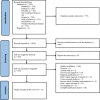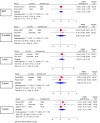Association between low-calorie sweetener consumption during pregnancy and child health: A systematic review and meta-analysis
- PMID: 39344708
- PMCID: PMC11650048
- DOI: 10.1111/mcn.13737
Association between low-calorie sweetener consumption during pregnancy and child health: A systematic review and meta-analysis
Abstract
We examined the association between low-calorie sweeteners (LCS) consumption during preconception, pregnancy, and breastfeeding and child health outcomes. A systematic search of electronic databases in PubMed, Embase, Cumulated Index to Nursing and Allied Health Literature, the Cochrane Library, Scopus, Web of Science, PsycINFO, ProQuest Health and Medical, ClinicalTrials.gov, and Google Scholar was conducted up to 21 September 2023. A random effects model with restricted maximum likelihood estimation was used for the meta-analysis. Seventeen eligible studies were included. The standardised mean difference (SMD) and 95% confidence interval (CI) in birth weight between those who frequently consumed LCS (≥1 serve/day) during pregnancy and those who did not consume LCS was 0.04 (0.00, 0.08) (four cohort studies). Any LCS consumption during pregnancy compared with no consumption was not associated with birth weight [SMD (95% CI) = 0.03 (-0.03, 0.08)] (four cohort studies). Any LCS consumption during pregnancy was not associated with body mass index z-scores. The weighted mean difference (95% CI) was 0.00 (-0.05, 0.06) at birth, 0.06 (-0.29, 0.40) at 6 months, -0.04 (-0.19, 0.10) at 1 year, 0.00 (-0.16, 0.17) at 3 years, and 0.10 (-0.15, 0.34) at 7 years of the child age, compared with no intake (five cohort studies). The odds of being overweight at 1 year among children exposed to LCS during pregnancy was 1.19 (OR [95% CI]: 1.19 [0.81, 1.58]) compared with unexposed children (two cohort studies). The effect sizes were not precise for all the outcomes as the 95% CI indicated the effect estimates could range from small protective to a higher risk. The effect of LCS consumption on child behaviour and cognition was inconsistent. There is not enough evidence to confirm LCS consumption during pregnancy affects birth weight and risk of overweight in children. However, frequent consumption increased birth weight and the risk of overweight at different ages, though the effects were imprecise. More robust research evidence is required as the quality of evidence is low.
Keywords: artificial sweetener; child; growth; meta‐analysis; nonnutritive sweeteners; preconception; pregnancy.
© 2024 The Author(s). Maternal & Child Nutrition published by John Wiley & Sons Ltd.
Conflict of interest statement
Nothing to declare. The last author Shao Jia Zhou is editorial board member of Maternal and Child Nutrition Journal.
Figures




References
-
- Azad, M. B. , Abou‐Setta, A. M. , Chauhan, B. F. , Rabbani, R. , Lys, J. , Copstein, L. , Mann, A. , Jeyaraman, M. M. , Reid, A. E. , Fiander, M. , MacKay, D. S. , McGavock, J. , Wicklow, B. , & Zarychanski, R. (2017). Nonnutritive sweeteners and cardiometabolic health: A systematic review and meta‐analysis of randomized controlled trials and prospective cohort studies. Canadian Medical Association Journal, 189(28), E929–E939. 10.1503/cmaj.161390 - DOI - PMC - PubMed
-
- Azad, M. B. , Archibald, A. , Tomczyk, M. M. , Head, A. , Cheung, K. G. , de Souza, R. J. , Becker, A. B. , Mandhane, P. J. , Turvey, S. E. , Moraes, T. J. , Sears, M. R. , Subbarao, P. , & Dolinsky, V. W. (2020). Nonnutritive sweetener consumption during pregnancy, adiposity, and adipocyte differentiation in offspring: Evidence from humans, mice, and cells. International Journal of Obesity, 44(10), 2137–2148. - PubMed
-
- Azad, M. B. , Sharma, A. K. , de Souza, R. J. , Dolinsky, V. W. , Becker, A. B. , Mandhane, P. J. , Turvey, S. E. , Subbarao, P. , Lefebvre, D. L. , & Sears, M. R. (2016). Association between artificially sweetened beverage consumption during pregnancy and infant body mass index. JAMA Pediatrics, 170(7), 662–670. 10.1001/jamapediatrics.2016.0301 - DOI - PubMed
-
- Barker, M. , Dombrowski, S. U. , Colbourn, T. , Fall, C. H. D. , Kriznik, N. M. , Lawrence, W. T. , Norris, S. A. , Ngaiza, G. , Patel, D. , Skordis‐Worrall, J. , Sniehotta, F. F. , Steegers‐Theunissen, R. , Vogel, C. , Woods‐Townsend, K. , & Stephenson, J. (2018). Intervention strategies to improve nutrition and health behaviours before conception. The Lancet, 391(10132), 1853–1864. 10.1016/S0140-6736(18)30313-1 - DOI - PMC - PubMed
Publication types
MeSH terms
Substances
Grants and funding
LinkOut - more resources
Full Text Sources
Medical

